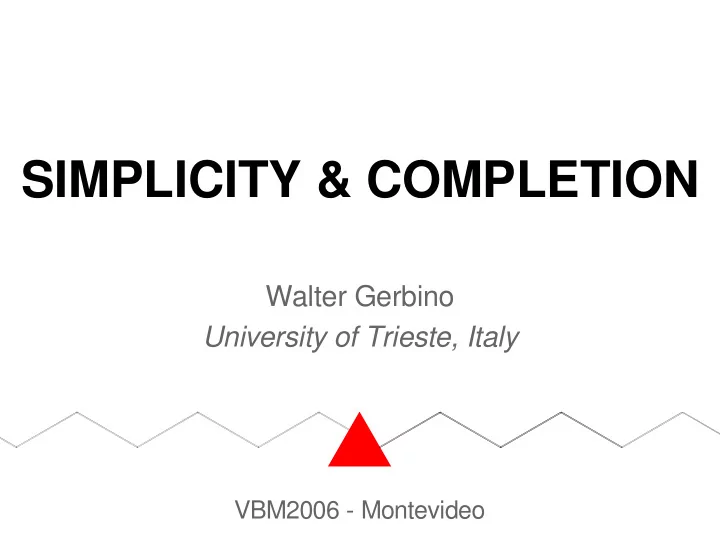

SIMPLICITY & COMPLETION Walter Gerbino University of Trieste, Italy VBM2006 - Montevideo
why completion? perception depends on stimulus information and internal constraints when the stimulus is incomplete, perception reflects internal constraints
topics amodal completion & occlusion beyond contours retinal constraints approximation vs. interpolation
different kinds of completion
virtual unifications
The horseman , 1918 (Bart van der Leck, 1876-1958)
amodal “covered” completions
but Michotte also discussed
les compléments amodaux “à decouvert”
lampshade for crossfusers
in monocular conditions
simplicity and 3D spheres simpler than disks spheres: why not in 2-circle patterns? minimizing interobject distance, shape, and global structure
eggs (Tse, 1999)
a continuum virtual unifications amodal uncovered surfaces amodal covered surfaces
amodal completion as a process
two hypotheses completed objects are recognized despite partial evidence completions are generated as parts of a full object model
modeling hypothesis amodal parts are produced completion is pre-categorical completion is constrained (by simplicity, among other things)
contours
line segmentation (Wertheimer, 1921, §27) we perceive /acegi.../bdfhl.../ + not /abefil.../cdghk.../ +
with closed adjacent contours front behind + behind front +
good continuation (Wertheimer, 1921, §29-30) local gc local gc + similarity similarity alone simplicity local gc vs. symmetry similarity?
a definition (Wertheimer, 1921, §29-30) Consider a curve corresponding to a simple mathematical function, large enough to allow observers to recognize the underlying function. Then, add a segment based on a clearly different function and another following the same principle. In general, the latter (not the former) will form a unit with the given curve.
minimizing the length of modal illusory contours
Petter’s rule easier than
Petter’s rule & undulation (modified from Kanizsa, 1984, 1991)
stratification length minimization explains direction width dissimilarity explains occurrence
undulation persists (also when width is balanced)
control for contrast polarity
control for orientation
minimal local depth the grey bar on the right looks undulated, though consistent with Petter’s rule
minimal depth
surfaces (perceived modal area)
less is more
(Kanizsa & Gerbino, 1982)
objects
cylinder on a block
cylinder into a block obliquity or non-parallelism?
oblique cylinder on a block
3D penetration amodal continuation explained by form regularization
joint undeterminacy
pencil in the block
two possibilities
the undeterminate intersection volume doubly owned (metaphysical) totally or partially empty divided among the two objects belonging to one object only
past experience?
orientation
surfaces (minimal amodal area)
equivalent solutions at the contour level
equivalent solutions at the contour level
estimating the vertex of an occluded angle (Fantoni, Bertamini, & Gerbino, 2005)
concave vs. convex angles
average localization= 80% 84% concave symmetric 74% convex symmetric 84% concave asymmetric 77% convex asymmetric
retinal constraints
46 (2006) 3142–3159
probe localization paradigm
retinal gap= 1.6 deg retinal gap= 0.8 deg 79% 61% 88% 59%
the field model (Fantoni & Gerbino, 2003; Gerbino & Fantoni, 2005)
GC field MP field
CHAINED VECTOR SUMS GC max - MP max FREE PARAMETER: GC-MP contrast = GC max + MP max
approximation
interpolation approximation
why a deformation? rounding due to the minimization of the amodal contour good continuation is irresistible (Gerbino 1978) shape approximation and contrast (Fantoni, Gerbino, & Kellman, submitted )
local effect
a byproduct of g.c.
approximation & contrast
approximation distorts visible contours
approximation & surface torsion
with occluder without occluder
∆ RMS= RMS without - RMS with
conclusions amodal completion is mediated by internal models modeling by approximation can distort modal parts
thanks
Completion phenomena are theoretically important because they reveal how the visual system overcomes the local gaps of optic information. Gestalt theorists proposed that amodal completion is driven by a tendency towards simplicity. I will discuss strengths and weaknesses of such an idea and refer to specific cases of 2D and 3D completion, supporting the following specific hypotheses: surface-level processes integrate contour-level processes; retinal constraints play a non trivial role; approximation explains the perceived shape of partially occluded surfaces better than interpolation.
Recommend
More recommend